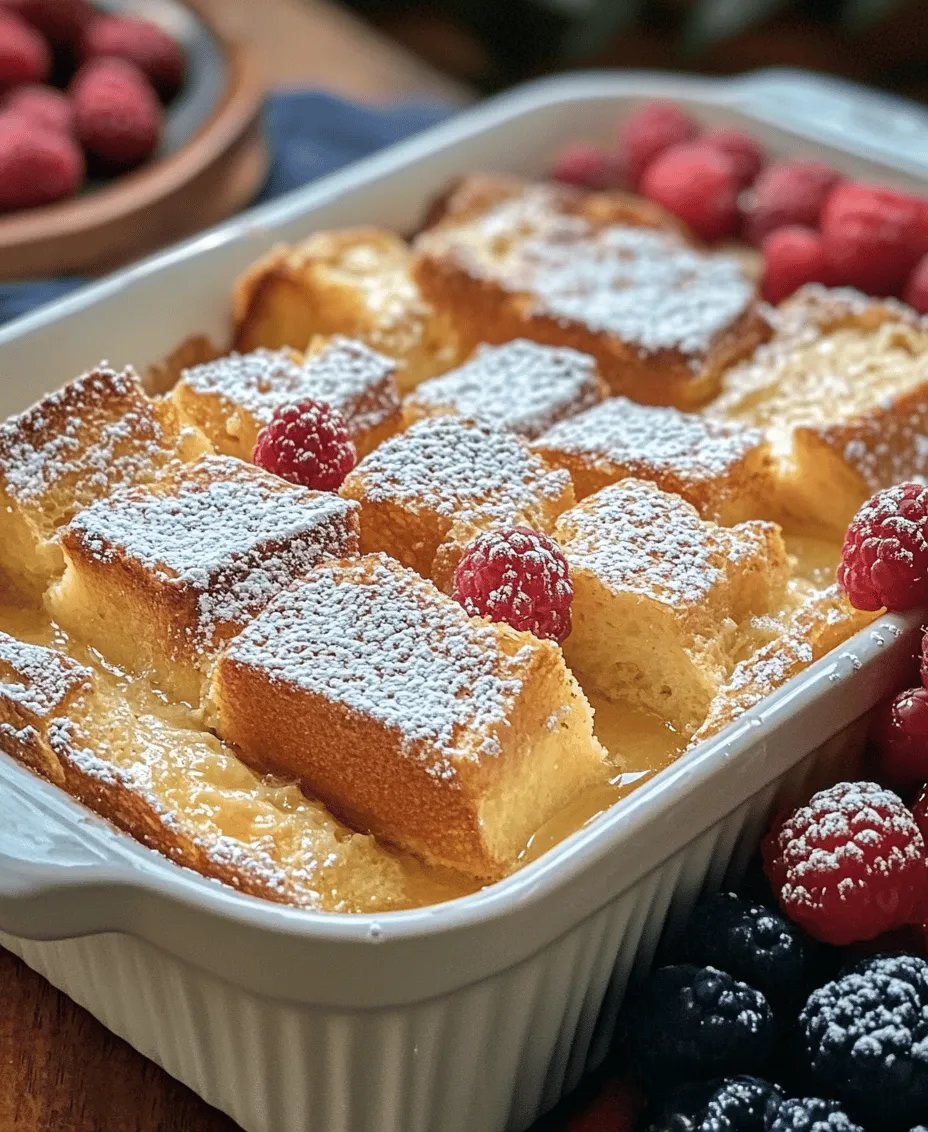Introduction
Breakfast casseroles have become a beloved staple in many households, especially for those who appreciate a hearty, satisfying meal to start their day. The charm of breakfast casseroles lies in their versatility, ability to feed a crowd, and the convenience they offer—preparing a delicious dish the night before means less time in the kitchen and more time enjoying the company of family and friends in the morning. Among the myriad options, the Overnight French Toast Casserole stands out as a delightful combination of rich flavors and comforting textures, making it a perfect choice for holiday gatherings, brunches, or even a leisurely weekend breakfast.
Imagine waking up to the warm, inviting aroma of cinnamon and vanilla wafting through your home, the anticipation of a delectable breakfast waiting for you. The Overnight French Toast Casserole embodies this experience, transforming everyday ingredients into a luxurious dish that feels indulgent yet remains accessible. Its delightful blend of custardy bread, sweet notes, and a hint of spice creates a breakfast that everyone will love.
Understanding Overnight French Toast Casserole
The origins of the French toast casserole can be traced back to the classic French toast itself, which has roots in ancient times when stale bread was reinvented into a delicious meal. The concept of soaking bread in a mixture of eggs and milk to create a custard-like texture is timeless, but the casserole variation elevates it to a new level of convenience and presentation. This dish has found its place in brunch culture, where it is often served alongside fresh fruit, whipped cream, or a drizzle of maple syrup, making it a favorite for special occasions and casual family breakfasts alike.
One of the key advantages of using stale French bread in this casserole is its ability to absorb the custard mixture without falling apart. This unique characteristic ensures that each bite is infused with flavor while retaining a pleasing texture. Stale bread, unlike fresh, has a firmer structure that allows it to soak up the egg and milk mixture efficiently, yielding a dish that is both sumptuous and satisfying.
The custard mixture itself is crucial to the success of the Overnight French Toast Casserole. This blend of eggs, dairy, and spices not only adds moisture but also creates that classic French toast experience. The richness from the eggs and the creaminess from the dairy come together to form a luscious filling that makes each bite a treat for the senses.
Key Ingredients and Their Roles
To create the perfect Overnight French Toast Casserole, it’s essential to use the right ingredients that contribute to its overall flavor and texture. Here’s a closer look at the key components:
French Bread
The star of this dish is undoubtedly the French bread. Using stale French bread is crucial, as it enhances the casserole’s texture and flavor absorption. Fresh bread, while soft and fluffy, can become overly soggy when soaked in the custard mixture. Stale bread, on the other hand, has a denser structure that holds up beautifully during the soaking and baking process. The slight crustiness of the stale bread provides a delightful contrast to the soft, custardy interior, resulting in a dish that is both comforting and satisfying.
Eggs
Eggs play a pivotal role in binding the ingredients together and creating the custard-like texture that defines French toast. They add richness and depth to the casserole, ensuring that each bite is decadent and flavorful. The proteins in the eggs coagulate during baking, providing stability to the casserole and helping it rise slightly, resulting in a fluffy interior.
Dairy
The choice of dairy is equally important in achieving the desired creaminess of the casserole. Whole milk and heavy cream are the preferred options, as they contribute to a rich mouthfeel and enhance the overall flavor profile. The combination of these two dairy products creates a luscious custard that envelops the bread, ensuring every piece is infused with the delightful creaminess that makes French toast so beloved.
Sweeteners
To balance the richness of the eggs and dairy, sweeteners play a vital role in the recipe. Granulated sugar adds a touch of sweetness, while maple syrup provides depth and complexity of flavor. The combination of these sweeteners enhances the overall taste of the casserole, making it a delightful treat that feels indulgent without being overly sweet.
Spices
The warm, aromatic spices of cinnamon and nutmeg elevate the dish and breathe life into the flavors. Cinnamon, a classic pairing with French toast, adds a comforting warmth, while nutmeg introduces a subtle depth that rounds out the flavor profile. These spices not only enhance the taste but also fill your home with an irresistible aroma as the casserole bakes.
Butter
Butter is essential in this recipe, both for flavor and for aiding in the baking process. It adds richness and a slight nuttiness to the casserole, which complements the other ingredients beautifully. Additionally, butter helps to create a golden, crispy top when baked, adding an appealing texture that contrasts with the soft interior.
Step-by-Step Preparation
Now that we have an understanding of the key ingredients and their importance, let’s delve into the step-by-step preparation of the Overnight French Toast Casserole. This simple process ensures a delicious dish awaits you in the morning with minimal effort.
Step 1: Gather Your Ingredients
Before you begin, gather all the necessary ingredients to streamline the preparation process. You’ll need:
– 1 loaf of stale French bread, cut into cubes
– 6 large eggs
– 2 cups of whole milk
– 1 cup of heavy cream
– 3/4 cup of granulated sugar
– 1/2 cup of pure maple syrup
– 1 tablespoon of vanilla extract
– 1 teaspoon of ground cinnamon
– 1/4 teaspoon of ground nutmeg
– 1/4 cup of unsalted butter, melted
Step 2: Prepare the Bread
Start by cutting the stale French bread into 1-inch cubes. If your bread is not stale, you can dry it out in the oven by spreading the cubes on a baking sheet and toasting them at 300°F (150°C) for about 10-15 minutes, stirring occasionally until they are slightly dried but not browned. This step ensures that your bread will absorb the custard mixture effectively.
Step 3: Make the Custard Mixture
In a large mixing bowl, whisk together the eggs, whole milk, heavy cream, granulated sugar, maple syrup, vanilla extract, cinnamon, and nutmeg. Whisk until the mixture is well blended and slightly frothy. This custard mixture is what will soak into the bread and create that soft, delicious texture.
Step 4: Assemble the Casserole
In a greased 9×13-inch baking dish, evenly distribute the cubed bread. Pour the custard mixture over the bread cubes, ensuring all pieces are saturated. Gently press down on the bread to make sure it absorbs the custard mixture evenly. Cover the dish tightly with plastic wrap and refrigerate overnight (or for at least 4 hours) to allow the bread to soak up the custard thoroughly.
Step 5: Preheat the Oven
The next morning, preheat your oven to 350°F (175°C). This step is crucial for ensuring even cooking and browning of your casserole.
Step 6: Bake the Casserole
Remove the casserole from the refrigerator and let it sit at room temperature for about 15 minutes before baking. Drizzle the melted butter over the top of the casserole to add flavor and promote browning. Bake in the preheated oven for 45-50 minutes, or until the top is golden brown and the center is set. You can check for doneness by inserting a toothpick into the center; it should come out clean.
Step 7: Serve and Enjoy
Once baked, allow the Overnight French Toast Casserole to cool for a few minutes before slicing. Serve warm, topped with additional maple syrup, fresh fruit, whipped cream, or a dusting of powdered sugar, if desired. The result is a delightful breakfast that will impress everyone at your table.
By following these steps, you will create an Overnight French Toast Casserole that is not only delicious but also perfect for any occasion. This dish offers a wonderful way to enjoy the flavors of French toast in a convenient and crowd-pleasing format.

Preparation of the Bread
The cornerstone of a successful Overnight French Toast Casserole is the bread. To achieve the ideal texture and flavor, begin by selecting a sturdy bread that can absorb the custard without falling apart. French bread, challah, or brioche are excellent choices due to their density and ability to hold up during soaking.
1. Cutting the Bread: Start by slicing your chosen bread into cubes. Aim for 1-inch pieces for uniform cooking and optimal custard absorption. If the bread is freshly baked, allow it to sit out for a few hours or overnight to slightly stale. This will help the cubes soak up the custard without becoming mushy.
2. Arranging the Bread Cubes: Once your bread is cut, place the cubes into a greased 9×13-inch baking dish. Spread them out evenly, ensuring there are no large gaps. This arrangement is crucial as it allows the custard to coat every piece properly. For added texture, consider layering the bread cubes with some cinnamon or nutmeg sprinkled in between. This not only provides flavor but also visual appeal.
Creating the Custard
The custard is what brings the casserole to life, providing the rich, creamy flavor that defines this dish. It’s essential to whisk the ingredients properly to ensure a smooth and well-combined mixture.
1. Whisking Ingredients: In a large bowl, combine eggs, milk (or a non-dairy alternative), sugar, vanilla extract, and a pinch of salt. Whisk vigorously until the mixture is completely homogenous. This step is vital; if the egg and milk are not fully combined, you might end up with clumps of egg in your casserole. For an extra depth of flavor, consider adding a splash of orange juice or a teaspoon of almond extract.
2. Incorporating Spices: If you enjoy a hint of spice, now is the time to add ground cinnamon or nutmeg to the custard mixture. Start with about a teaspoon of cinnamon for a warm flavor profile that complements the sweetness of the bread and sugar.
Combining Ingredients
Once your custard is ready, it’s time to combine it with the bread cubes. This step is crucial for ensuring every piece is evenly coated.
1. Pouring the Custard: Gently pour the custard mixture over the bread cubes in the baking dish. Avoid pouring too quickly, as this can cause the bread to float or clump together.
2. Distributing the Custard: Using a spatula or your hands, gently press down on the bread cubes to ensure they soak up the custard. This process is important; it guarantees that each piece of bread absorbs the flavors and moisture. Once everything is combined, cover the dish tightly with plastic wrap or aluminum foil.
Chilling Overnight
Refrigerating the casserole overnight is a vital step that enhances the flavors and allows the bread to fully absorb the custard. This time allows the spices and vanilla to meld beautifully, resulting in a more flavorful dish.
1. Flavor Development: Chilling the casserole for at least 6-8 hours gives the bread time to soak up the custard, ensuring a rich and satisfying texture. The longer it sits, the better the flavors will develop.
2. Morning Preparation: When you’re ready to bake, remove the casserole from the fridge and let it sit at room temperature for about 30 minutes while you preheat your oven. This step helps in achieving an even bake.
Baking the Casserole
Now comes the exciting part: baking your Overnight French Toast Casserole.
1. Preheat Instructions: Preheat your oven to 350°F (175°C). Proper preheating is crucial for achieving even cooking and a beautiful golden color. If your oven has hot spots, consider rotating the casserole halfway through baking for uniform results.
2. Baking Process: Bake the casserole for 45-55 minutes, or until it is puffed and golden brown on top. To check for doneness, insert a toothpick into the center; it should come out clean or with a few moist crumbs, indicating that the custard has set. If the top begins to brown too quickly, you can cover it loosely with aluminum foil.
3. Cooling Time: Once baked, allow the casserole to cool for about 10-15 minutes before serving. This cooling period allows the custard to set further and makes cutting the casserole easier. It also helps to prevent burns from hot custard.
Serving Suggestions
Your Overnight French Toast Casserole is now ready to be served! Here are some delightful suggestions to enhance your breakfast experience:
1. Recommended Toppings: Before serving, dust the casserole with powdered sugar for a touch of sweetness and a beautiful presentation. Fresh berries like strawberries, blueberries, and raspberries not only add color but also a refreshing burst of flavor that balances the dish’s richness.
2. Additional Flavor Pairings: Consider offering a variety of syrups, such as maple syrup, berry syrup, or even flavored syrups like vanilla or cinnamon. A dollop of whipped cream can elevate the dish, adding creaminess and decadence.
3. Complete Brunch Experience: To create a well-rounded brunch, consider serving the casserole with sides like crispy bacon, seasoned sausage, or a fresh fruit salad. This mix of savory and sweet will please a variety of palates and make your meal feel special.
Nutritional Information
While delicious, it’s also good to be mindful of the nutritional aspects of your Overnight French Toast Casserole.
1. Nutritional Overview: Each serving typically contains a healthy balance of carbohydrates, protein, and fats. The inclusion of eggs and milk provides protein, while the bread contributes carbohydrates for energy. Depending on the bread used, you can expect around 300-400 calories per serving.
2. Portion Sizes: Serving size may vary based on individual appetite and dietary needs, but a standard portion is around 1/8 of the casserole. For those looking to manage caloric intake, consider cutting smaller portions and pairing them with fresh fruit.
3. Customization for Dietary Needs: If you have dietary restrictions, the casserole can easily be customized. For a gluten-free option, use gluten-free bread. You can also substitute dairy milk with almond, soy, or oat milk to make it suitable for lactose intolerance or vegan diets. Adjusting the sugar content is also possible for those watching their sugar intake.
Conclusion
The Overnight French Toast Casserole is a delightful dish that combines convenience with rich, comforting flavors. Its ability to be prepared the night before makes it an ideal choice for busy mornings, holidays, or leisurely weekend brunches with family and friends.
Sharing this casserole at gatherings not only brings joy but also creates lasting memories around the breakfast table. Its versatility allows for numerous variations and toppings, ensuring everyone can enjoy a slice tailored to their tastes. Whether you’re celebrating a special occasion or enjoying a casual weekend, this casserole is sure to impress and satisfy. Embrace the ease and deliciousness of this dish, and watch as it becomes a beloved staple in your breakfast repertoire.



